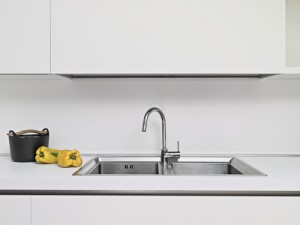 Selecting the right sink and faucet for your kitchen renovation is easier said than done. It’s a fairly permanent decision and the incredibly vast assortment of styles and combinations is enough to give anyone choice overload.
Selecting the right sink and faucet for your kitchen renovation is easier said than done. It’s a fairly permanent decision and the incredibly vast assortment of styles and combinations is enough to give anyone choice overload.
The simplest way to avoid being paralyzed by too many options is to begin narrowing down the field.
We’ll start with the sink.
The easy stuff first
Settling on a material is probably the least stressful part of the process. For the sake of simplicity let’s take unique custom-made solutions like polished concrete out of the equation and focus only on mass-produced manufactured sinks. You know, the kinds that come right out of the box ready to install.
Here are your options:
- Stainless steel—easy to clean, professional look, plenty of longevity
- Enameled Cast-Iron—super strong, colorful, built to last for generations but more prone to chipping than fireclay
- Fireclay—stain- and rust-proof, classic “porcelain” feel, fully ceramic design that may not last as long compared to cast-iron
- Copper—top-notch aesthetic beauty, forms unique patina over time, anti-bacterial properties, requires more upkeep versus other materials
How many basins?
If you plan on installing a garbage disposal, it’s pretty much a no-brainer that you’re going to need a two-basin sink. Otherwise, it’s simply a matter of personal choice. Both one and two basin sinks offer distinct pros and cons.
One basin sinks are great because they’re extra wide, so you never have to struggle when washing oversized pots and pans.
Two basin sinks have the advantage of dividing your work area into dual purposes—one side for greasy pots and pans and the other side for dishes and cutlery, or one side for dirty dishes and the other side for food prep.
Many brands such as Kohler offer sinks with disproportionate bowl sizes to take advantage of both styles. With one large and one medium basin, you’ll have space for king-size pans while maintaining a separate work area.
Hidden or apron-front?
While most homeowners prefer a more contemporary design, apron-front or farmhouse style sinks are making a big comeback.
If your renovation plans include the repurposing of your old cabinetry, you’ll most likely want to choose a sink style that matches what you’ve already got. Cutting existing cabinetry to accommodate an apron-front sink is a complex endeavor.
Top-mount or undermount?
Undermount sinks are gorgeous and allow you to seamlessly wipe food scraps from the countertop into the basin. But they tend to be more expensive and more difficult to install.
While a top-mount sink works well with any and all countertop materials, undermount models are not ideal for tile or laminate counters. Granite, soapstone, marble, and concrete work best for supporting the weight of an undermount sink.
Another thing to consider is the fact that top-mount sinks generally come ready-made with holes to install your faucet. Undermount models require holes be drilled into the wall or countertop, complicating faucet installation.
On to the faucet
The general rule of thumb here is to buy the most expensive faucet you can afford. Why? Because a luxurious faucet acts as the focal point for your entire kitchen, and all the extra gizmos and whiz-bangs really do improve usability.
If you’ve got the money for the Brizo or Delta no-touch technology, go for it. You’ll be glad you did.
The first step to finding the right faucet is to set a budget and to use that price point to narrow the field. If $600 is the most you can spend, shop in the $450-$600 price range.
Don’t skimp. This is the faucet you’ll be using for years to come.
Functionality
Style is important but function trumps form on your hierarchy of needs. If you’d like a sidespray, eliminate models that don’t offer one as an option.
Pull-down, pullout, no-touch. Think about what you’d like your faucet to do before worrying about how it ought to look.
One handle or two?
This is mostly a personal preference thing, but bear in mind that some sinks are designed to accept only one style of faucet.
Style
The next step is to weed out models that simply won’t work with the overall theme of your design motif. Is your new kitchen meant to feel modern? Traditional? Old-fashioned? Vintage?
You don’t need to be a professional designer to be able to look at a faucet and determine the basic category it fits into. Define your theme and only consider models that match.
At some point you’ll need to take the plunge and just pick one, but by constricting your options by price, functionality, number of handles and general style first, the final selection is a whole lot more manageable.
The last step
Most faucet models sold by major manufacturers come in a variety of finishes. Choosing the perfect combination of color and gloss can lead to yet another “I hope I get it right” moment.
At the end of the day it’s pretty simple. Gather up the major accessories in your kitchen and find the finish that matches best.
